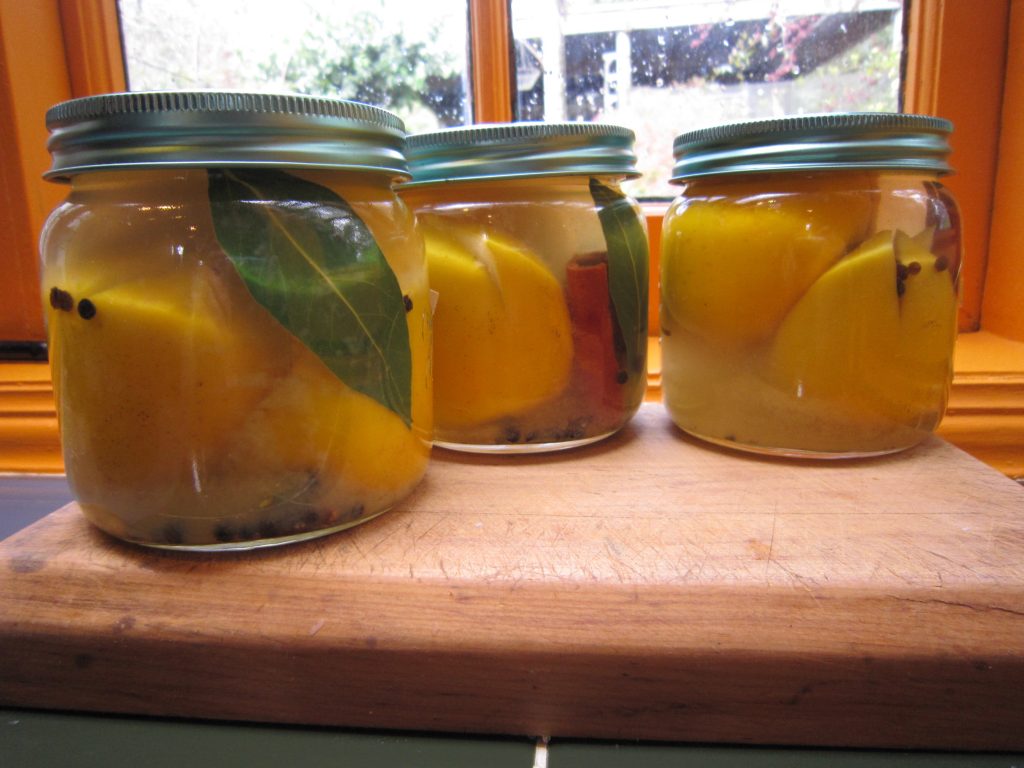There is no great mystery to preserving fruit. All it takes is some fresh unblemished produce, preserving jars, lids and seals. I have been preserving fruit more than twenty years and have never sterilized my jars. Never had any problems with bad food either. I simply give the jars a thorough wash in hot soapy water and then a good hot rinse. If I had to do all the sterilizing business I’d never do any bottling. I just don’t have the time and it becomes too much of an ordeal. Yesterday I preserved lemons. Here’s how I did it.

This time I used eight of the smaller AGEE preserving jars. For each jar calculate either 2 medium or 3 small sized lemons.
Ingredients;
Fresh lemons about 20
Rock salt.
Bay leaves fresh or dried.
Whole black peppercorns.
Whole allspice.
Cinnamon sticks.
Whole cloves.
Method;
Half fill a large pot or preserving pan with water and bring to the boil.
While the water is heating wash the lemons and put aside.
Wash your preserving jars in hot soapy water, then rinse thoroughly. Leave in the sink half submerged in very hot water until you are ready to use them. Meanwhile add the washed lemons to the now boiling water. Allow the lemons to boil for about three minutes.
Speed is now of the essence so while the lemons are boiling assemble the spices, salt and bay leaves at your work space.

Have the screwbands and lids within easy reach. Beside the stove I have a warmed (with boiling water) frypan in which I will place and fill my jars one at a time.
Now take the lemons out of the simmering water and put them in another container close by. We don’t want the lemons to be overcooked but we want the water they were in to stay at near boiling point. Keep it simmering. This is my easy overflow method but it won’t work unless the jars are still very warm and the liquid we overflow the jars with is near boiling point. Take your first jar from the sink and place it in the frypan.
Take a lemon and cut it crosswise on the bottom end opening it up a little and put one generous teaspoon of rock salt inside the opening. Carefully place the lemon cut-end facing upwards into the jar. Do the same to another lemon and carefully squeeze it in beside the first one. Then put a few peppercorns, alllspice, cloves, small piece of cinammon bark and a bay leaf into the jar.
Now pour from the simmering lemon water into the jar until it is just overflowing. Make sure there is no debris on the top rim of the jar, position the seal on top and carefully fasten on the screw band. After filling and sealing each jar you can return the overflowed juice from the frypan, back into the pot of simmering lemony water. Continue filling the rest of the jars with two or three lemons each depending on their size.
I usually leave the screw bands on overnight and give the jar a good wipe before placing in my pantry. You can tell if the seal is airtight when there is an indentation in the centre.
If you have one that doesn’t seal airtight, just keep it in the fridge, otherwise they will keep indefinitely. Many Moroccan and Middle Eastern recipes include preserved lemons. They can also be used in soups or stews and are particularly good with lamb. I make a budget-friendly lamb stew with neck chops. Fresh rosemary sprigs and my preserved lemon makes the dish. Ka pai.
I have had ‘preserve lemons’ on my kitchen to-do list for WEEKS now, but I still have no preserved lemons, and they are beginning to rot under the tree. It’s not pure laziness; I am a little intimidated by the whole preserving thing. So I took a look on the web to get it all demystified, and found your most perfect pic-by-pic description and instruction. You make it all so simple and do-able. Naturally, I was curious about your other posts, and what I found is a cherished little cache of your own trustworthy sustenance techniques that you are generous enough to share.
Thank you Trisha! I have bookmarked your site and I look forward to your future posts.